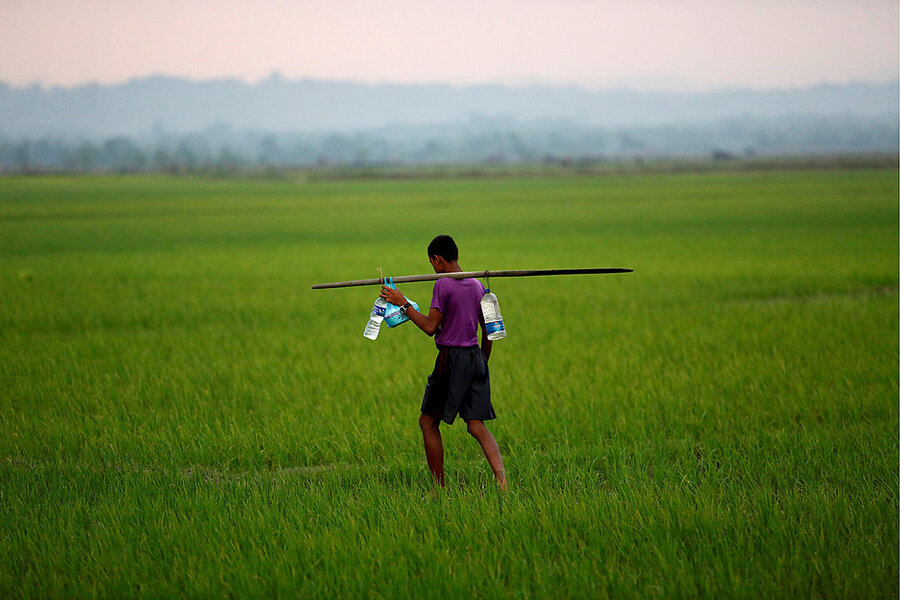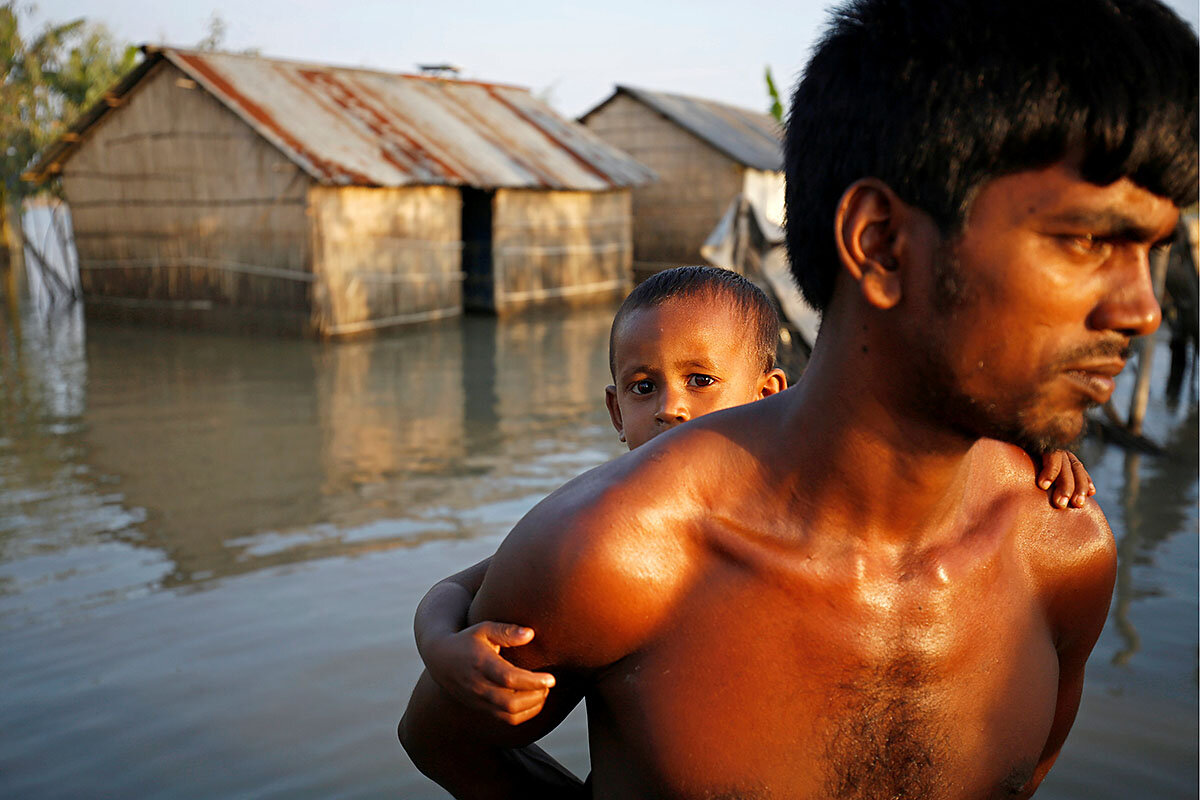As waters recede, Bangladesh takes stock – and plans for more flood-prone future
Loading...
| Tangail District, Bangladesh
For two months of every summer – monsoon season in this corner of South Asia – Sufia lives on an island in a sea of flooded rice fields. The only way to reach her house is by dinghy, on account of the one dirt road that leads to it being under water.
Yet this monsoon season was far worse than anything Sufia has experienced in decades. In late August, while hurricane Harvey was battering Texas and Louisiana, heavy rain led to devastating floods and landslides across the region. More than 1,200 people have died and at least 41 million people in Bangladesh, India, and Nepal have been directly affected, according to the International Federation of Red Cross and Red Crescent Societies (IFRC).
The dangerously high flood waters forced Sufia and her husband to abandon their home, a bare-bones hut of corrugated-steel walls held up by wooden beams and concrete pillars in the countryside of Tangail District, about 50 miles north of the capital, Dhaka. The couple took shelter in a nearby engineering college for much of August. By the time the flood waters began to recede earlier this month, their rice crop had been ruined and their 20-odd chickens were dead.
“We’ll have to wait two or three months before we can plant rice again,” says Sufia, who uses only one name. In the meantime, she and her husband have taken out a loan to buy food and repair their home. “There’s nothing else we can do.”
Bangladesh, a densely populated country of 165 million people, has been inundated with what its Ministry of Disaster Management and Relief calls the most serious floods in 40 years. Monsoon flooding is a fact of life in this delta nation, where two-thirds of land is less than five meters above sea level – making it all the more vulnerable to climate change. Although the rains are still deadly, Bangladesh is increasingly able to cope with flooding, experts say, in part because of its quickly growing economy. As gross domestic product increases, so does the economic toll of disasters – but the cost to human lives can decrease.
Prevention and response
The challenges of recuperating from this summer’s floods are steep. More than 730,000 homes have been partially or entirely destroyed. And with roughly one third of the country’s terrain submerged, more than 1.6 million acres of crops have been damaged.
Most tragically, the floods have so far killed at least 145 people in Bangladesh. While that’s no small number, it’s far lower than the number of people who died in two other massive floods that hit the country in recent years: one in 1988 that killed more than 2,300 people and another in 1998 that killed more than 1,000.
In part, that's because Bangladesh has more resources for prevention and response. The government has spent millions of dollars to improve weather forecasting, public health outreach, and rural support systems, all of which have been made possible by the country’s ongoing economic boom. Many schools and mosques are now designed to double as shelters, and public health campaigns have reduced the spread of water-borne diseases.
The Asian Development Bank estimates that Bangladesh’s economy grew by 7.1 percent in 2016, its fastest expansion in 30 years and one of the fastest in the world. The country’s poverty rate has plummeted as a result. More than 16 million people came out of extreme poverty between 2000 and 2010, according to the World Bank. The extreme poverty rate dropped to 12.9 percent last year, down from 18.5 percent in 2010.
Prime Minister Sheikh Hasina praised her country’s disaster relief efforts in a speech to the United Nations General Assembly on Thursday. “We have efficiently responded to the massive flood that has stricken the entire south Asian region this year,” she said.
Yet as Bangladesh’s economy continues to grow – driven largely by its garment industry – the second-largest in the world – so too does the economic cost of major floods like the ones that hit this summer. The World Resources Institute estimates that 4.75 percent of the county’s GDP, or $5.4 billion, is affected by river flooding in an average year – and this year’s floods have been far from “average.”
“Bangladesh has made considerable progress in preparing for these kinds of natural disasters,” says Kazi Shahidur Rahman, a humanitarian affairs specialist at the UN office in Dhaka. “Now we have to focus on figuring out how to protect our gains.”
The challenge ahead
One of the most immediate concerns is food security. The floods devastated Bangladesh’s agriculture sector, which employs nearly half of the country. The widespread damage has raised fears of an impending food shortage. Although Prime Minister Hasina extolled Bangladesh’s ability to feed itself in her UN address – for the last six years, the country has produced enough rice to be self-sufficient – the floods are forcing the government to import 1.5 million tons of rice.
The floods also pose a challenge for Bangladesh’s all-important garment sector, which was worth $28 billion last year. The industry employees about 4 million people. But for the next two months, Mofazzal, a middle-aged man in Tangail District, won’t be among them. The small saree factory at which he works has been temporarily shut down because of flood damage.
For now, Mofazzal plans to repair his house and look for work as a rickshaw puller in the nearby town. “Our crops are ruined,” he says. “The government still hasn’t come to help us.”
The Department of Disaster Management has promised to deliver support, including bundles of tin and cash for the flood victims to rebuild their houses. But as the Dhaka Tribune reported on Saturday, many victims are still waiting.
As the flood waters recede, researchers and government officials are looking ahead to the next major flood. Bangladesh is currently developing a plan for managing its delta, the largest in the world, through 2100. One of plan’s central aims is to secure the country against threats posed by climate change. A 2013 report by The World Bank says Bangladesh will be among the countries in South Asia most affected by rising global temperatures.
“Climate change is going to make these kind of extreme weather events more and more common,” says Rezaur Rahman, a professor in the Institute of Water and Flood Management at the Bangladesh University of Engineering and Technology. “We have to be ready for them. That’s our next big challenge.”







